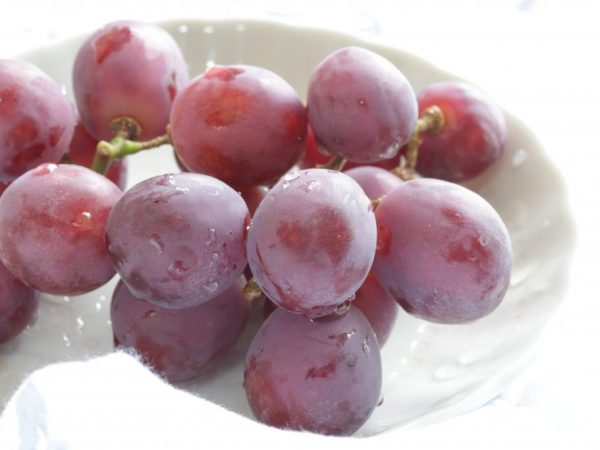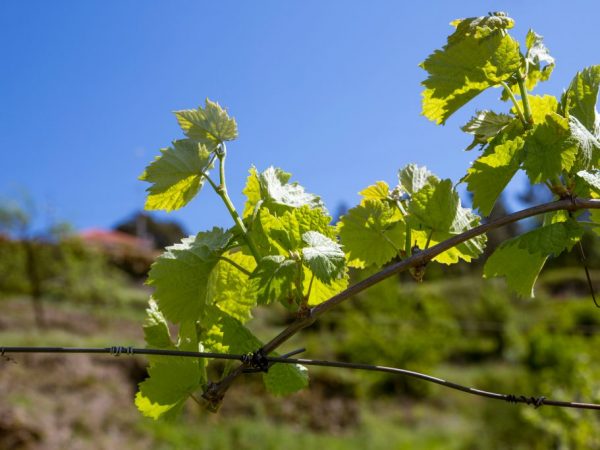Description of grapes Red Globe
One of the many representatives of American selection is the Red Globe grape, which means "red ball" (Globe). The variety is popular in Asian countries. In Europe, he gained fame in the mid-90s.

Description of grapes Red Globe
Characteristic
According to the description, it is a medium late or late ripening variety. Red Globe is the record holder for storage. In optimal conditions, it lasts 3-4 months. During this entire period, the berries retain their freshness and bright color. The culture is characterized by a low calorie content: 67 kcal per 100 g.
Description of the bush
Red Globe grape bushes are weak or medium-sized, depending on soil and climatic conditions, therefore, rootstocks are used on which this species is grafted. It has shown good compatibility with most rootstocks, with the exception of Teleki 5A.
The grapes of the Red Glob variety have a high fruitfulness of the buds. Shoot productivity is high. Each forms 2-4 clusters of inflorescences. Weak shoots are removed, leaving healthy ones, no more than 6 per fruit arrow. The vine on the trellis always ripens well, up to 2 m in height.
Description of the fetus
Red Globe is one of the largest-fruited varieties. Its bunch reaches a weight of 2 kg. The berry is impressive in size, from 10 to 15 g. This result is obtained naturally, without additional thinning of the bunch, in which the "red balls" would be even larger.
The grapes are dark pink or reddish in color. Under the natural powdery coating that covers the berries, it appears purple.
On the surface of the berry, there is a longitudinal strip dividing it into 2 equal parts. If the fruit is cut, it will be seen that the consistency of the pulp is dense, with a pinkish tinge, juicy. There are 4 large seeds inside. If they are dark, the grapes have already matured.
The longer the fruit remains on the vine, the greater the concentration of sugars in them. At the same time, the acidity is reduced, the taste of the fruits is harmonious and neutral.
Growing
Red Globe is propagated by cuttings. In cultivation, he is finicky and requires effort from the gardener.
Cuttings of the plant are planted in the open ground in the fall. This event is held 1.5 months before a tangible decrease in ambient temperature. During this time, the seedling will have time to take root, thoroughly consolidating itself in the soil. The culture is planted in spring. Wait until the temperature reaches 5 ° C or 10 ° C.
Landing will be successful if a number of conditions are met:
- sunny place;
- lack of drafts;
- loose, fertile soil.
A deepening is dug up to 0.5 m deep, the roots of the seedling are placed in it. The bottom is covered with gravel, rotten wood, and fertile soil is poured on top with a mound. A tube is placed on the side, which serves for internal irrigation. The roots of the seedling are shaken off and kept in a solution of clay and rotted mullein. Then the seedling is immersed in the prepared plot of land, the roots are straightened. Everyone is covered with earth.
In order for soil particles to occupy all the cavities between the branched roots, the stem is slightly shaken up and down.This helps to prevent stagnation of moisture in the root system and the formation of decay processes, the development of diseases.
Plant care

The grapes must be watered abundantly
The Red Glob grape variety is responsive to feeding and watering. With their participation, it is possible to achieve impressive results in growing crops. After flowering and ovary of grapes, the vines must be watered abundantly.
Fertilizer
The plant is periodically fed. In the spring, nitrogen-phosphorus-potassium fertilizers are applied. In a later period, overdoses are avoided: they stimulate the unreasonable growth of greenery, due to which the development of flowers is suspended.
Growth regulator treatment is not required for Red Globe. Here, varietal agricultural techniques are used, associated with the thinning of the bunches after flowering. In this version, the berries are of natural size and large, weighing over 20 g.
Diseases and pests
Red Globe is not resistant to fungal diseases. Only gardeners who regularly use fungicides to control pests can cope with its cultivation. The most common are 2 diseases:
- Mildew. It affects the green part of the plant. Yellow-brown oily spots appear on the leaves, which turn black over time. Unripe fruits dry up and fall off, the rest acquire a sour taste. With a severe course of the disease, the vine loses its leaves and the harvest of the current year.
- Odium. It infects the ground part of the vine. Dirty gray or brown spots appear on the upper part of the leaves, green shoots. The berries stop growing and dry up. With a late lesion, they crack and rot. Odium contamination of grapes is recognized by its characteristic odor, reminiscent of rotten fish. Of the pests, phylloxera (parasitic insect), itch (mite) and leafworm (butterfly) are dangerous.
Bordeaux mixture (300 g of lime and vitriol per 10 liters of water) can help the culture in the fight against these diseases. The consumption of funds in the processing process is 2 liters per 10 sq. m.
Prophylaxis
In order for the grapes to produce a good harvest, actions should be taken in advance to reduce the risks of diseases and damage by pests:
- breeding varieties resistant to pests, diseases;
- preventive spraying;
- creation of ventilation in the crown;
- foliar dressing with microelements, potassium and phosphorus.
Conclusion
Red Globe surprises with the size of the berries. You can grow this species, if you show maximum patience, study all the features and preferences of this grape.

